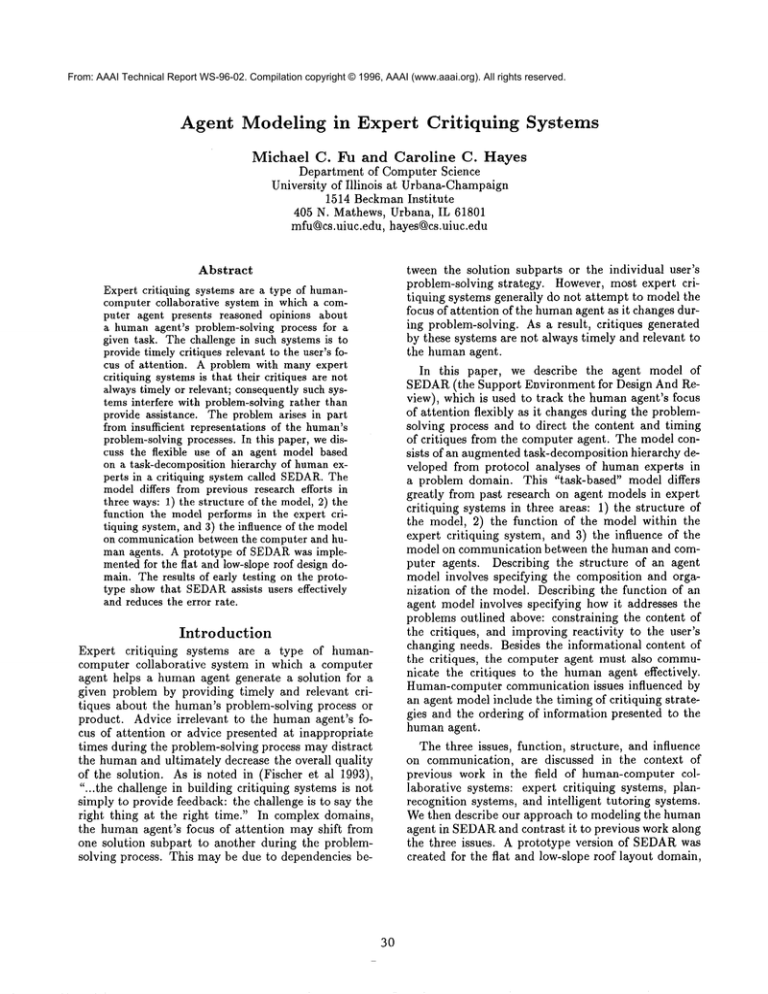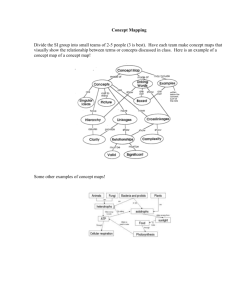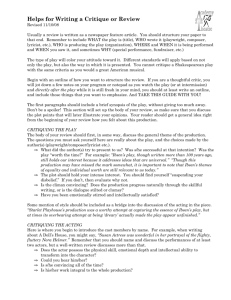
From: AAAI Technical Report WS-96-02. Compilation copyright © 1996, AAAI (www.aaai.org). All rights reserved.
Agent Modeling in Expert Critiquing
Systems
Michael
C. Fu and Caroline
C. Hayes
Department of Computer Science
University of Illinois at Urbana-Champaign
1514 BeckmanInstitute
405 N. Mathews, Urbana, IL 61801
mfu@cs.uiuc.edu, hayes@cs.uiuc.edu
Abstract
tween the solution subparts or the individual user’s
problem-solving strategy. However, most expert critiquing systems generally do not attempt to model the
focus of attention of the humanagent as it changes during problem-solving. As a result, critiques generated
by these systems are not always timely and relevant to
the human agent.
In this paper, we describe the agent model of
SEDAR(the Support Environment for Design And Review), which is used to track the humanagent’s focus
of attention flexibly as it changes during the problemsolving process and to direct the content and timing
of critiques from the computer agent. The model consists of an augmentedtask-decomposition hierarchy developed from protocol analyses of human experts in
a problem domain. This "task-based" model differs
greatly from past research on agent models in expert
critiquing systems in three areas: 1) the structure of
the model, 2) the function of the model within the
expert critiquing system, and 3) the influence of the
model on communication between the human and computer agents. Describing the structure of an agent
model involves specifying the composition and organization of the model. Describing the function of an
agent model involves specifying how it addresses the
problems outlined above: constraining the content of
the critiques, and improving reactivity to the user’s
changing needs. Besides the informational content of
the critiques,
the computer agent must also communicate the critiques to the humanagent effectively.
Human-computer communication issues influenced by
an agent modelinclude the timing of critiquing strategies and the ordering of information presented to the
human agent.
Expert critiquing systems are a type of humancomputer collaborative system in which a computer agent presents reasoned opinions about
a humanagent’s problem-solving process for a
given task. The challenge in such systems is to
provide timely critiques relevant to the user’s focus of attention. A problem with manyexpert
critiquing systems is that their critiques are not
alwaystimely or relevant; consequentlysuch systems interfere with problem-solving rather than
provide assistance. The problem arises in part
from insufficient representations of the human’s
problem-solvingprocesses. In this paper, we discuss the flexible use of an agent model based
on a task-decomposition hierarchy of humanexperts in a critiquing system called SEDAR.
The
modeldiffers from previous research efforts in
three ways: 1) the structure of the model, 2) the
function the model performs in the expert critiquing system, and 3) the influence of the model
on communicationbetween the computer and human agents. A prototype of SEDAR
was implementedfor the flat and low-slope roof design domain. The results of early testing on the prototype show that SEDAR
assists users effectively
and reduces the error rate.
Introduction
Expert critiquing
systems are a type of humancomputer collaborative
system in which a computer
agent helps a human agent generate a solution for a
given problem by providing timely and relevant critiques about the human’s problem-solving process or
product. Advice irrelevant to the human agent’s focus of attention or advice presented at inappropriate
times during the problem-solving process may distract
the humanand ultimately decrease the overall quality
of the solution. As is noted in (Fischer et al 1993),
"...the challenge in building critiquing systems is not
simply to provide feedback: the challenge is to say the
right thing at the right time." In complex domains,
the human agent’s focus of attention may shift from
one solution subpart to another during the problemsolving process. This may be due to dependencies be-
The three issues, function, structure, and influence
on communication, are discussed in the context of
previous work in the field of human-computer collaborative systems: expert critiquing systems, planrecognition systems, and intelligent tutoring systems.
Wethen describe our approach to modeling the human
agent in SEDAR
and contrast it to previous work along
the three issues. A prototype version of SEDARwas
created for the flat and low-slope roof layout domain,
3O
plans, which is then used to guide the system’s behavior. Each type of system will be examined in terms
of the three issues of agent structure, function, and
influence on communication.
Human-Computer
Boundary
Partial
Solution
Solution
Analysis
Expert Critiquing
Systems
Mastaglio’s LISP-CRITIC(Mastaglio 1990) uses a domain and user model to tailor its explanations in terms
of LISP programming concepts and functions underlying the critiquing rules of the system’s knowledgebase.
The modeling component consists of four major parts:
1) a representation of what the user knows about LISP
concepts and functions, 2) a dialog history of explanations that the user has been exposed to, 3) a preference record of LISP functions and deactivated rules,
and 4) a code analysis module that provides statistical data of acceptance and rejection of critiques in the
past. Besides the primary function of tailoring explanations, the modeling component is used to determine
what subset of the overall rule base to fire for each
individual programmer. The model influences communication between human and computer by providing
explanations that the user understands.
Fischer’s HYDRA
(Fischer et al 1993), which critiques kitchen layouts, uses a different model of the
human agent. Instead of modeling the human’s knowledge, as in LISP-CRITIC, HYDRA
elicits
and maintains a record of the user’s overall goals (or functional specifications) for the kitchen layout. Examples of functional specifications for a kitchen layout
would include the size of the family, the right- or
left-handedness of the cook, how often cooking is performed in the kitchen, etc. HYDRA
uses its "specific"
critics to detect inconsistencies between the evolving
kitchen layout and the functional specifications. The
use of the agent model allows HYDRAto provide
critiques relevant to the user’s overall goals for the
kitchen.
A significant problem with the above agent models
is that they do not address the issue of changing focus during the problem-solving process. In complex
domains, the user may solve parts of the problem at
a time or interleave the synthesis of different problem
subparts. Ideally the computer agent should be able
to adapt its critiques automatically to this changing
context. The model of the user’s domain knowledge in
LISP-CRITICallows for the tailoring of explanations
for each critiquing episode, but it does not provide a
means to adapt the set of critiquing knowledge automatically to the humanagent’s changing focus of attention. Similarly, while the goal model of HYDRA
helps
to provide critiques relevant the user’s overall goals for
the project, it does not provide a frameworkto adapt
to changing user focus during the design process.
]
Analysisof
Critiques
Human
Agent
Critique
Generation
Computer
Agent
Figure 1: Humanand Computer Agents in Expert Critiquing Systems
and an informal evaluation showed that the system is
able to help experienced designers reduce the number
of errors in their roof layouts.
Agents
and Agent Modeling
in Expert
Critiquing
Systems
In expert critiquing systems, the humanagent and the
computer agent collaborate to achieve a higher-quality
solution than could be obtained by either alone. The
role of the humanagent in an expert critiquing system
is to direct the problem-solvingactivities of the collaborative system and to select and implement critiques
generated by the computer agent. The role of the computer agent in an expert critiquing system is to critique
the humanagent’s partial solution and problem-solving
process. The critiques serve not only to point out specific problems with the solution, but also to prompt
additional reflection by the human. Solution synthesis
by the human agent may be tightly interwoven with
critique generation by the computer agent, resulting
in a continual cyclical flow of information across the
human-computer boundary (Figure 1). Each cycle
solution generation, analysis, critique generation, and
critique analysis is called a critiquing episode.
Related
Work
In this section, previous work involving agent models
is summarized. Three classes of systems discussed in
the literature that often employ agent models are expert critiquing systems [(Fu 1995), (Mastaglio 1990),
(Fischer et al 1993)], intelligent tutoring systems, and
plan-recognition systems (Suchman 1987). Unlike expert critiquing systems, intelligent tutoring systems
are intended for novices in a domain; the emphasis
is on educating the human user rather than improving the quality of solutions. Plan-recognition systems
use plan-based agent models. User actions are employed to select a plausible user plan from a library of
Plan Recognition
Systems
Plan recognition systems are another type of humancomputer collaborative system in which a model of the
31
human user in the computer agent strongly influences
system behavior. These systems map observed user
behavior onto a set of plans stored in a plan library;
the inferred plan represents the system’s belief of the
user’s plans and intentions. The plan is then used to
direct the behavior of the system. For example, Suchman (Suchman 1987) describes several experiments involving a plan recognition system for assisting inexperienced users of photocopying machines. Initially,
the system asks the user a series of questions about
the user’s original documentsand desired copies. This
statement of intent is used to select a single plan from a
library of plans. The plan is then presented to the user
as a set of procedural instructions. As the user follows
the plan, the user changes the state of the photocopying machine in predictable ways; the changes to system
state constitute a trace of the user’s actions. As Suchman notes, "The design assumption is that by detecting certain of the user’s actions, the system can follow
her course in the procedure and provide instructions
as needed along the way." Significant problems with
this approach arise when the system misinterprets the
user’s actions, whena single plan is insufficient to describe the scope of the user’s problem-solving behavior,
and when plans are used to predict the future behavior
of the humanagent. In several experiments involving
this plan recognition system and novice users, Suchman found that the inflexibility of plan usage in the
system led to numerous severe human-computer communication lapses after only a few incorrect actions
were performed by the users.
Intelligent
Tutoring
Systems
Like expert critiquing systems, intelligent tutoring systems use agent models which influence system behavior
greatly. In general, agent models in intelligent tutoring systems are termed as student models to reflect the
teacher-student relationship between the computer and
human. A typical student model is similar in structure and function to LISP-CRITIC’s user model, and
is used to track the student’s current understanding of
the domain. Besides influencing the content of the system’s explanations, the model is also used to evaluate
the student’s specific needs and to help the system’s instructional module prepare appropriate individual instruction.
Agent
Modeling
in
SEDAR
The agent model of SEDARuses an augmented taskdecomposition hierarchy to represent the problemsolving process of humanexperts for a given task. By
flexibly tracking the user’s changing focus of attention
during the problem-solving process, the system is able
to generate relevant critiques at critical decision points
without constraining the user to a particular solution
path, as in the case of the plan-recognition system reported by Suchman. Unlike the agent models based
32
on a user’s knowledge of domain facts (e.g. LISPCRITICand intelligent
tutoring systems), the taskbased model of SEDARrepresents experts’ problemsolving processes for a domain. This process model is
flexible enough to model the behavior of manyusers,
not just one user.
Structurally, the model is most similar to the taskdecomposition models used in automated design systems [(Brown ~ Chandrasekaren 1986), (Mittal
Dym1986)]. Functionally, the model is used to represent the system’s beliefs about the problem-solving
state of the humanuser. The model accomplishes this
by constraining the set of critiquing knowledgeapplied
in each critiquing episode. The use of the model influences the manner of communication between the human and computer; it determines the time at which
various critiquing strategies are used and the order in
which information is presented to the user.
Throughoutthis section, our discussions will be illustrated with examples from the domain of flat and lowslope roof layout for commercial and industrial buildings.
Structure
The task-based model represents the problem-solving
process of experienced humans in the problem domain.
The process is represented as a decomposition hierarchy of tasks that may be encountered during problemsolving. Besides the task-subtask relationship,
the
model is augmented with semantic links describing
ordering relationships and potential interferences between the tasks. Unlike intelligent tutoring systems,
which are intended to interact with mainly inexperienced users, SEDARis intended to interact with humans with prior problem-solving experience in the domain. Thus the composition and organization of the
model reflects this level of domaincompetence.
Figure 2 shows a portion of the task-based model
for the flat and low-slope roof layout domain. The
rectangular boxes in the example represent tasks that
the user may perform. The task at the left, RoofLayout, is the most abstract task and represents the
overall task of roof layout. It is decomposedinto subtasks, Roof-Component-Layout, Equipment-Layout,
and Footprint-Layout. These subtasks are further decomposed into their constituent subtasks. The leaf
tasks on the far right of the figure (e.g. Drain-Layout,
Walkway-Layout, Air-Handler-Layout, etc.) represent
the layout of a specific type of roof object or subsystem.
The heavy dotted lines, or part-of links, represent the
task-subtask decomposition. Before-task links, shown
as single-arrowhead solid lines, are possible ordering
relationships between tasks, and are drawn from observations of humanexpert behavior. An example of this
is the before-task ordering between Equipment-Layout
and Roof-Component-Layout; we observed that humans tend to lay out large, heavy mechanical equipment before other roof components. Interferes-with
links, shown as double-arrowhead dashed lines, represent potential interferences among tasks at the same
level of abstraction in the problem-solving process.
During system use, the tasks in the model are activated to represent the user’s place in the design process and current focus of attention. Each task in the
modelone of three possible activation states: inactive,
active, or focus. In Figure 2, inactive tasks have no
shadow, active tasks have a light gray shadow, and focus tasks have a dark gray shadow. Focus tasks are believed to be within the direct focus of the user’s most
recent actions. A task becomes a focus task under
two conditions: 1) the trigger for the task is activated
by a user action, or 2) the task is an ancestor of
focus task. For the flat and low-slope roof domain
each task has a set of design objects (e.g. drains, airhandling-units, etc.) that serve as its trigger. When
the user places a drain on the design, the Drain-Layout
task becomes a focus task because one of its triggers is a drain design object. The ancestors of DrainLayout (Drainage-System-Layout,
Membrane-Layout,
and Roof-Component-Layout)are also focus tasks. Active tasks are non-focus tasks that: 1) are directly related to a focus task by an interferes-with relation, or
2) were focus tasks previously. These tasks represent
relevant considerations outside the current user focus.
Finally, inactive tasks are those that have not been
addressed yet by the user.
Structurally,
the task-based model may be compared to task-decomposition hierarchies found in automated design systems like PRIDE (Mittal & Dym
1986) and AIRCYL(Brown & Chandrasekaren 1986).
In the AIRCYL
architecture, a hierarchically organized
communityof design agents represent the hierarchical
structure of the artifact (an air cylinder). Each design
agent has a repertoire of design plans to accomplish its
tasks at its level of abstraction in the hierarchy. The
AIRCYL
architecture does not deal with interferences
between tasks; constraint checking occurs only within
the plan steps within each task, and design activity occurs only along the task-subtask relationships; finally,
interleaving of the design of different artifact subparts
is not supported. Mittal, Dym, and Morarja discuss
the hierarchical representation of "design goals" in the
PRIDEsystem for designing paper handling systems
within copiers. Each goal in PRIDErepresents the design of a small set of parameters that describe some
part of the artifact being designed. In SEDAR,the
tasks of the agent model are not constrained to represent solely parameterized design, and thus are more
general than the design goMsof PRIDE.
Function
The agent model serves to influence the behavior of
SEDARin three significant ways. First, the model is
used to constrain the knowledge applied during each
critiquing episode. This helps to reduce the run-time
complexity from the application of critiquing knowl-
edge, and does not constrain the user to a particular
ordering of task completion. Second, the model allows
the system to be reactive to changes in the users’ focus of attention. Finally, user feedback regarding the
appropriateness of the advice offered during critiquing
episodes is captured in a limited way by providing a
means for the user to deactivate individual tasks in
the agent model.
Each task in the agent model is associated with a set
of relevant critiquing knowledge. For each critiquing
episode, only critiquing knowledgeassociated with focus and active tasks are applied. This approach has
two major advantages. First, only critiques relevant
to the user’s focus of attention are generated; this at
least partially addresses the problem in advice-giving
systems of saying the right thing at the right time. As
the user’s focus of attention shifts, the set of focus and
active tasks in the agent model and hence the set of
knowledge applied during the critiquing episode also
change to match the focus shifts. Besides providing
critiques directly relevant to the user’s current focus
of attention, the system also provides critiques relevant to tasks that the user should consider because of
potential interferences. Second, since only a limited
subset of the critiquing knowledgeis applied for each
critiquing episode instead of the entire set, run-time
complexity due to the application of knowledgeshould
be reduced. One of the goals of a future evaluation of
SEDARwill be to determine the amount of reduction
of run-time complexity. The technique described here
is a muchstronger approach to constraining the set of
knowledgeapplied during each critiquing episode than
that taken by LISP-CRITIC. It is a more general approach than the rule application method of HYDRA,
which applies only rules directly related to a placed
design object.
One of the key problems with early plan recognition systems was their inflexibility in adapting to a
user’s changing focus of attention. In SEDAR,we address this problem by using the task-based model to
track the user’s problem-solving process rather than
to constrain it to a particular sequence of tasks. This
is important in expert critiquing systems because the
locus of control of the problem-solving process is with
the human user. The model is updated whenever new
information (knowledge about user actions) becomes
available, and the effects of the update on the behavior of the system are immediate.
Besides being adaptive to the user, SEDAR
also provides a user adaptation capability for certain aspects
of the system. This capability is used to capture user
feedback on the appropriateness of the advice offered
during critiquing episodes. First, the user may "turn
off" tasks in the agent model so that they are not included in the inferencing performed in subsequent critiquing episodes. A similar capability is provided for
individual rules in the critiquing knowledge base and
individual critiques. This feature allows the user to
part-ofrelation
"- ..... ~
Hatch-Layout
focustask
~]
~
Roof-Partitioning
j
interferes-with
relation
before-task
relation
~~k~you~
1
~
activetask
Figure 2: A Portion of the Task-Based Model for Flat and Low-Slope Roof Layout
lation, and manner. A correct quantity of information must be passed between the two participants. Too
little or too muchinformation may distract and confuse the receiving agent. Quality refers to the truthfulness of the information being passed. Relation, or
relevance, means that the information should be topical within the context of the conversation. Finally, we
must consider the manner in which communication occurs. In previous sections, we have discussed how the
agent model of SEDAR
addresses the issues of quantity
and relation; by interpreting the user’s focus of attention using the task-based model, only critiques relevant
to the user’s focus of attention are presented for each
critiquing episode. The issue of quality is implicitly
dealt with in human-computer collaborative systems;
the human agent assumes that the computer agent is
providing truthful information. In this section, the
manner of communicationand its relation to the agent
model is discussed. Specifically, the use of the agent
model in SEDAR
affects the timing of critique presentation and the order in which information is displayed
to the user.
Providing critiques at inappropriate times is distracting to the human user. Like an unexpected interjection during conversation, poor timing of critiques
serves to interrupt the thought processes of the recipient. (Silverman 1992) provides a conceptual framework for three different timings of critiques: beforetask, during-task, and after-task critiques. Before-task
N_ewObject...
MoveObject
__Reslze
Object
Delete Object
ChangeSlot Values
V Error Prevention
v’ ErrorCorrection
Goals...
Critiques...
SaveRoofLayout...
OpenRoofLayout...
Figure 3: The SEDARAction Menu
alter the informational content of the critiques generated by the system. Second, each of the various critic
agents in the system may be deactivated. Thus the
user also has a limited ability to adapt the system to
provide specific types of situated advice.
Interagent
Communication
Communication between the human and computer
agents in expert critiquing systems should embody
the four principles of coherent, cooperative dialog described by Grice (Grice 1975): quantity, quality, re-
34
Command:
Command:
(new-object)
Please
I~loce
thenew
obiect.
/
Figure 4: An Example of the Error Prevention Critiquing Strategy
critiques are used to preempt commonlyrecurring errors before the task is executed by the humanagent.
If the user maybe safely interrupted, then during-task
critiques help to eliminate errors while the context of
the situation is fresh in the human agent’s memory.
After-task critics detect errors after the task is completed. These types of critiques may be implemented
using the task-based model of SEDAR.For example,
suppose that the user decides to add an object (a masonry chimney) to the roof layout by selecting the
"New Object..."
entry on the SEDARaction menu
(Figure 3). The selection of the masonry chimney object triggers an update of the tasks in the agent model.
After the agent modelis updated, the before-task critic
(called the error prevention critic) then computes"offlimits" areas (shown as shaded areas around objects)
on the existing design, and displays them directly on
the roof drawing (Figure 4). The purpose of this display is to warn the human agent of potentially poor
design decisions before the actual placement of the object. In an alternative modeof interaction, the human
user mayuse the task-based model to direct the activity of an after-task critic by specifying a particular solution component from the task-based model for analysis. In Figure 5, the user has selected the EquipmentLayout task, which causes the after-task critic to check
the layout of all equipmentin the roof field. After the
critiques are generated, the user may examine each of
the graphical/textual critiques in turn.
35
Relevant information presented in an unordered way
may also adversely affect the user’s understanding of
the advice given by the system. SEDAR
uses the state
of the agent model to order the information presented
to the user; critiques resulting from rules associated
with focus tasks are presented before those from rules
associated with active tasks. Figure 6 shows an example of a critique of a chimneyillegally placed within the
minimumspecified distance (one foot) from another
chimney. While the system also has advice regarding
the placement of a roof access mechanism,the critique
resulting from the focus Chimney-Layouttask is given
first to the user.
Prototype
Evaluation
and Discussion
The prototype of SEDARfor flat and low-slope roof
layout was evaluated in two experiments. The first
experiment was a system usability evaluation, which
rated the performance of SEDAR
along various usability issues. While the full results of this experiment are
reported elsewhere (Fu 1995), one outcome was an informal verification that the functional decomposition
of roof subsystems of the task-based model was appropriate and that the system was usable.
The second experiment measured the prototype system’s error reduction effectiveness. Two roof layout
tasks were presented to five system evaluators at different levels of expertise. Twoof the evaluators were
experts, having extensive backgrounds in architectural
Activation State Name
|hierarchy)
On
DECK-LAYOUT
On
VAPO
R-RETARD
E R-LAYO
UT
On
INSULATION-LAYOUT
!!!!!!
On
MEMBRANE-LAYOUT
iiiiiii
iii
On
PENETRATION-LAYOUT
On
VENTILATION-SHAFT-LAYOUT ii!!J
On
On
DRAINAGE-SYSTEM-LAYOUT
ii!!]!i
On
DRAIN’LAYOUT
i iiiJJi
On
DRAINAGE-AREA-LAYOUT
On
SUMP-LAYOUT
!!ii
On
SCUPPER-LAYOUT
liiiiil
On
FLASHING-SYSTEM-DESIGN
,’’!i
On
EDGE-FLASHING-DESIGN
iii/~
On
EQUIPMENT-FLASHING-DESIGN jjJtr
..........................................
Q.n
............................................................
R.0.0FTC0.MPQN
E.NT:!~LASH!NG:DE.S!
G_i!!ii
.,=.-LA¥o=
iiiii
II]1] t I I ~ I -- --.~,’,,i[l]ll
On
On
On
..
AIR-HANDLER-LAYOUT
WALKWAY-LAYOUT
CHIMNEY-LAYOUT
IfJ]
~J
Jl
Figure 5: Specifying a Particular Solution Component
to Critique
File Edit View Assist DrawConstruct Modify
Help
~
IIit
~EXPLANAT ~ll~lli1~
133.6eg&4&563:
MASDNRY-CH[MS-1
rqu~t
be o.’1;
te,~’l;
Render Model CADRE
i~i~lJl~li~
t £oo’c ~way £rorq NASDNRY-CHIH~-P.
t~,lllCenter/Dynamic/ExtentslLefttPreviousNmex[vVindow/<ScaleCX/XP)>
Dthercorner:
3ommand:
Figure 6: Exampleof ~ Critique for ~ MisplacedChimney
36
design. Two evaluators had backgrounds in architectural design but were not practicing architects, and
thus were considered intermediates. Finally, the last
evaluator was a novice, having no previous architectural design experience. Each evaluator was asked to
complete one roof layout without any critic agents activated (no advice offered) and one with all of the critic
agents activated (all possible advice offered). The
experiment showed that SEDARhelps to reduce the
number of errors made by expert and intermediate level
designers, but the novice. The first expert made 15 errors, and SEDAR’scritics identified 14 of them which
the designer then corrected. The second expert made
eight errors and SEDAR’scritics pointed out seven of
them. The system was also able to help the two evaluators of intermediate experience, resulting in similar error reduction rates. One issue that became clear when
working with the intermediate designers was that they
required additional explanations (supplied by the experimenter) of concepts in roof design to clarify the critiques and suggestions generated by the system. This
issue was especially important in the case of the novice
evaluator; there were too many gaps in the user’s domain knowledge for SEDARto provide effective support. The novice simply did not understand SEDAR’s
critiquing well enough for them to be of use.
During the evaluation of the SEDARprototype, designers commented on additional services that they
would have liked for SEDARto provide. The most
commonlyrequested service was the capability to detect suboptimal arrangements of objects. A significant
question, for future work, is how the task-based agent
model of SEDARcan be used to influence suggestion
generation.
Another suggestion from the evaluators was to add
a learning component to SEDAR.The primary desire
was for a means of adding knowledge to the domainspecific critiquing knowledge base. Weare currently
examining methods for effective knowledge acquisition
which will enable users to each modify or customize
the knowledgebase to their individual needs.
Conclusions
In human-computercollaborative problem-solving systems, computer models of the human agent may be
employed to improve the interaction between the computer and human agents. Previous work on models for
expert critiquing systems has focused on using models
of the human agent’s factual knowledge of the domain
and overall goals for the solution, in order to direct critiquing activities of the system. SEDARuses a model
of the problem-solving process rather than a model of
domain knowledge or solution goals. Wecall this a
task-based agent model because it is an augmented
task-decomposition hierarchy reflecting the problemsolving process of humanexperts in the problem domain. This model is used to track the user’s focus
of attention during problem-solving and determine the
37
subset of critiquing knowledgerequired for each critiquing episode. As the user works on different parts of
the solution, the modelis updated to reflect the user’s
changing focus, and the subset of knowledge applied
is changed to match this new critiquing focus. The
model is used in a flexible way because it is used to
track rather than to direct the user’s problem-solving
process. The model also influences the manner of communication between the human and computer agents;
its frameworkmaybe used to direct the timing of various critics and to order the information presented to
the user. The results from an informal evaluation of a
system prototype for the flat and low-slope roof layout
domain are promising, and have illustrated
the system’s capability to reduce the number of errors made
by experienced roof designers.
References
Brown, D., and Chandrasekaren, B. 1986. "Knowledge and control for a mechanical design expert system". IEEE Computer 19(7):92-100.
East et al, E. 1995. The Reviewer’s Assistant System: System Design Analysis and Description. Technical report, U.S. ArmyConstruction Engineering Research Laboratory.
Fischer et al, G. 1993. "Embeddingcritics in design
environments". The Knowledge Engineering Review
8(4):285-307.
Fu, M. 1995. Using a Task-Based Model of Design for Flexible Control in an Expert Critiquing System. Master’s thesis, University of Illinois at UrbanaChampaign.
Grice, H. 1975. "Logic and conversation". In Syntax
and Semantics 3: Speech Acts. NewYork: Academic
Press.
Mastaglio, T. 1990. "User modelling in computerbased critics". In Proceedings of the 23rd Hawaii International Conference on System Sciences, Volume
3: Decision Support and Knowledge-Based Systems,
403-411. Los Alamitos: IEEE Computer Society
Press.
Mittal, S., and Dym,C. 1986. "PRIDE:an expert system for the design of paper handling systems". IEEE
Computer 19(7):102-114.
Silverman,
B. 1992. Critiquing
Human Error:
A Knowledge-Based Human-Computer Collaboration
Approach. New York: Academic Press.
Suchman, L. 1987. Plans and Situated Actions: The
Problem of Human-Machine Communication. New
York: Cambridge Unversity Press.
Zhou et al, H. 1989. "CLEER:An AI system developed to assist equipment arrangements on warships".
Naval Engineers Journal 101(3):12-137.





